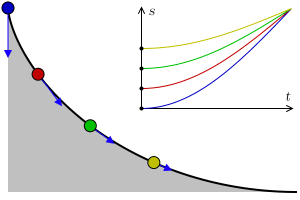Brachistochrones

The brachistochrone (Greek brachystos shortest, chronos time) is the path between a starting point and an end point at the same height or lower, on which a friction-free moving mass point slides the fastest to the end point under the influence of gravitational force . The low point of the path can be lower than the end point.
The body glides to the target on such a path faster than on any other path, for example on a straight path, although it is shorter.
At the same time, this curve is a tautochrone , i.e. H. from every point on the curve, the ground point takes the same time to reach the bottom. This fact is exploited in the so-called cycloid pendulum , in which the pendulum mass swings on a tautochrone.
shape
The brachistochrone is part of a cycloid .
history
Johann I Bernoulli dealt with the problem of the fastest case. In 1696 he finally found the solution in the brachistochrone. Today this is often seen as the birth of the calculus of variations .
In 1673 Christiaan Huygens published in his treatise Horologium Oscillatorium an accurate pendulum clock with a cycloid pendulum, in which he made use of the fact that the evolution of the cycloid itself is a cycloid again. However, the advantage of the accuracy is offset or negated by the increased friction.
function
The brachistochrone can be described in a parametric representation , that is, its points can be represented as a position vector that changes with a parameter. As a function of the angle (in radians ) by which the wheel with radius turned when rolling, the and coordinates are:
The following is helpful for understanding this curve: The radius times the angle "point of contact of the circle-circle center-brachistochron point" is the distance that has already been rolled.
Derivation
Consider in the - plane, a curve along which the ground point from the start with consecutive time goal glide.
He has the kinetic energy
and the potential energy
Here is the height in the gravitational field and the acceleration due to gravity .
If the initially resting mass point slides away from the origin, the total energy is preserved along its orbit and has the initial value zero,
This can be resolved after . The derivative of the inverse function, which indicates what time it is when the particle passes through the location , is the inverse of this
If we integrate over the range from 0 to , the running time to be minimized results as a functional of the trajectory
In order to follow up on the designations commonly used in physical variation problems, we name the integration variable , designate it with and, for the sake of simplicity, minimize the functional multiplied by. So we're minimizing the impact
with Lagrangian function
Since the Lagrangian does not depend on the integration parameter, the time , the energy / Hamilton function belonging to the Noether theorem is
received on the web for which becomes minimal. The function thus satisfies the equation with a positive constant
- or
like a particle that falls vertically from the peak in the Kepler potential .
Instead of solving and integrating this equation with separate variables , one simply confirms that
is a parametric solution to this equation, where one
exploits. So the path we are looking for is given parametrically by
The last decomposition makes it clear that the path is composed of the position vectors of the hub of a wheel with a radius that rolls under the axis plus the spoke vector that initially points upwards and is rotated with the angle . The curve is the path of an edge point of a rolling wheel.
Special features of the train
- The path is independent of the mass and weight of the body, i.e. independent of the magnitude of the acceleration due to gravity.
- Likewise, a rolling ball that absorbs rotational energy does not change anything in the ideal curve.
- The tangent at the starting point is vertical.
- If two brachistochrones have the same gradient between the start and end point, they are similar .
- If the gradient is not less than 2 / π (63.66%), the end point is the lowest point of the curve; if the gradient is smaller, the lowest point is between the start and end point.
- If the slope is 0, i.e. the start and end point are at the same height, the curve is symmetrical.
photos
Web links
- Article on the history of the brachistochron problem
- Brachistochronous Construction
- Brachistochrones in the MacTutor History of Mathematics archive (English)
- Java animation for the cycloid
- GIF animation from Education Highway Upper Austria on the tautochrony of the cycloid
- GeoGebra model for interactive testing with 10 stations between start and end point
- Cyclobahn, a subway with a cycloid route
supporting documents
- ↑ Acta eruditorum. (1696). See Istvan Szabó: History of Mechanical Principles. Third corrected and expanded edition 1987, p. 110, ISBN 978-3-0348-9980-2 .






















![T [y] = {\ frac {1} {{\ sqrt {2 \, g}}}} \ int _ {0} ^ {{\ overline {x}}} \, {\ sqrt {{\ frac { 1 + ({\ frac {{\ mathrm d} y} {{\ mathrm d} x}}) ^ {2}} {- y}}}} {\ mathrm d} x](https://wikimedia.org/api/rest_v1/media/math/render/svg/3d2a5fb13c988f1ad50fd890130e63531ec16085)



![W [r] = \ int \, {\ sqrt {{\ frac {1 + ({\ frac {{\ mathrm d} r} {{\ mathrm d} t}}) ^ {2}} {r}} }} {\ mathrm d} t](https://wikimedia.org/api/rest_v1/media/math/render/svg/3607b1dddbc8c859cb67ebf708a33bc145b4e353)



![W [r]](https://wikimedia.org/api/rest_v1/media/math/render/svg/953d5382862218239fdb18ed779acfed523d8d01)











